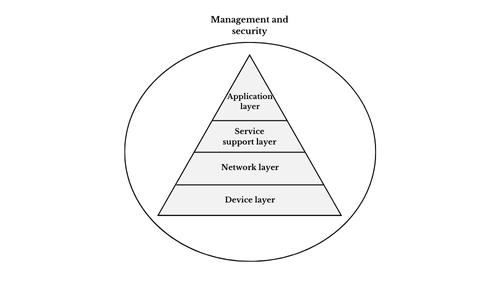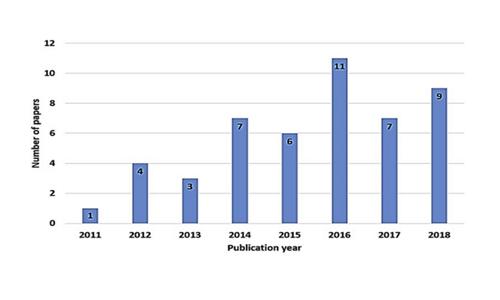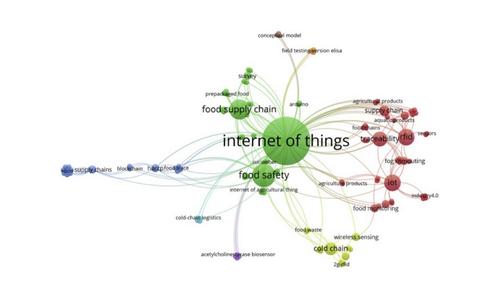INTRODUCTION
- The Internet of Things (IoT) has altered how data are collected and expanded the Internet’s vision to include every object that can receive or transmit digital data. As a result, the IoT has the potential to be a vast source of information.
- The phenomenal growth in machine-to-machine (M2M) connections, which brings together people, processes, data, and things to make networked connections more relevant and valuable (Cisco, 2019, pp. 1-33), is a glaring indicator of the growth of IoT. M2M connections have increased from just under a billion in 2017 to 3.9 billion by 2022.
- IoT can be defined as “Things having identities and virtual personalities operating in smart spaces using intelligent interfaces to connect and communicate within social, environmental, and user contexts” or “Interconnected objects playing an active role in what might be called the Future Internet.”
- The levels of the IoT architecture are depicted in Fig. 1: device layer, network layer, service support layer, application layer, administration layer, and security layer, among others [1].

Figure 1: The levels of the IoT architecture [1]
- The applications of IoT technology have extended to food product development and food safety evaluation.
Literature on IoT in food safety:
- The first paper on IoT in food safety was published in 2011, and the number of publications quickly rose, reaching a high in 2016 (11 articles), as shown in Fig. 2. In 2018, 9 articles were published in papers [1].

Figure 2: Published papers on the application of IoT in food safety [1]
Bibliometric Networks on IoT in food safety
- The bibliometric network for the applications of IoT in food product development is shown in Figure 3, wherein keywords are represented by circles.
- The circle size represents the number of articles with the related term in their keywords. Terms that occur frequently tend to be clustered together in the representation.
- In this scenario, the keywords were divided into eight clusters, four of which are significant in size. The green cluster includes topics linked to the Internet of Things technologies, food safety, and the food supply chain.
- RFID, IoT, and traceability phrases make up the red cluster. The yellow cluster is more concerned with cold chain management, wireless sensing, and food waste, whereas the blue cluster is more concerned with HACCP, supply chains, and blockchain [1].

Figure 3: Studies on the application of IoT in different domains related to food product development [1]
Application areas of IoT in food safety
- IoT can be used in food safety management systems, which track food supply chains. Tracking helps to ensure the safety of food products and improve their quality.
- Food management systems have substantially enhanced due to the ease with which data is collected using the Internet of Things (IoT) [2].
SWOT Analysis of IoT
|
Strengths |
Weaknesses |
Opportunities |
Threats |
|
– It saves time and helps to resolve issues about food safety quickly. -Economical in the long run -Facilitates collaboration |
-The process for ensuring food safety through IoT must be standardized. – High implementation costs – Employees must continuously update with the developments in IoT
|
– The efficiency of IoT can be improved – Potential to be environment-friendly |
– People’s apprehension about adopting new technologies |
Conclusion
- This study reviewed the available literature on IoT solutions for the food industry that are relevant to food safety. A literature review was conducted using scholarly works produced in English and disseminated in peer-reviewed publications. The bibliometric networks were used to examine the pertinent publications and the connections between the authors, institutes, nations, and materials.
- The literature on IoT applications for the food sector that are pertinent to food safety was studied for this study. The literature was assessed using academic works written in English and published in peer-reviewed journals. The relevant articles were examined, and the relationships among the authors, institutes, countries, and content were investigated using the bibliometric networks.
- According to the research, the Internet, RFID, and WSN were the most frequently employed communication technologies.
- Despite the positive overall results and the reported success of some deployments, it is evident that more research and innovation are needed to realize the promise of IoT fully.





